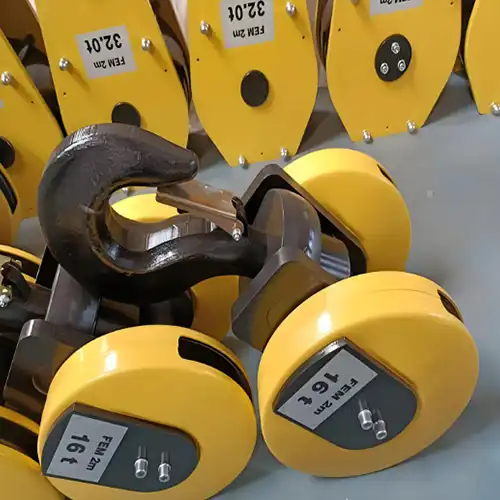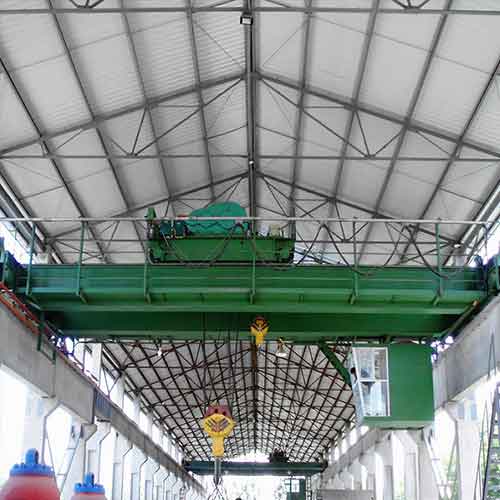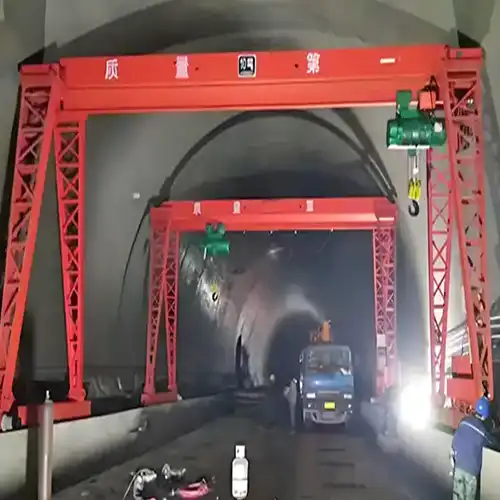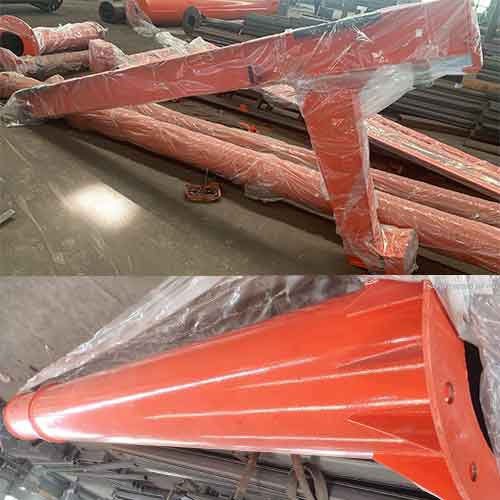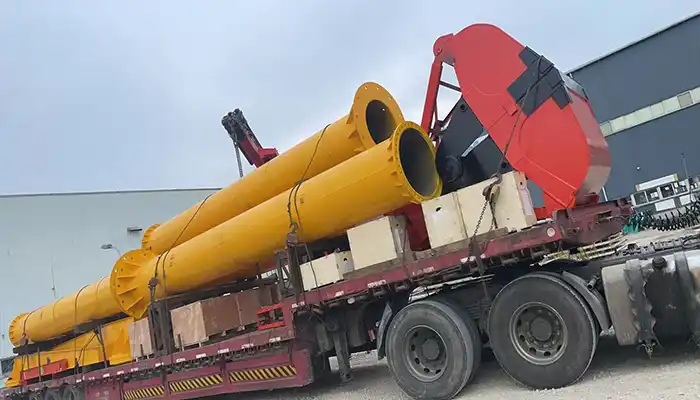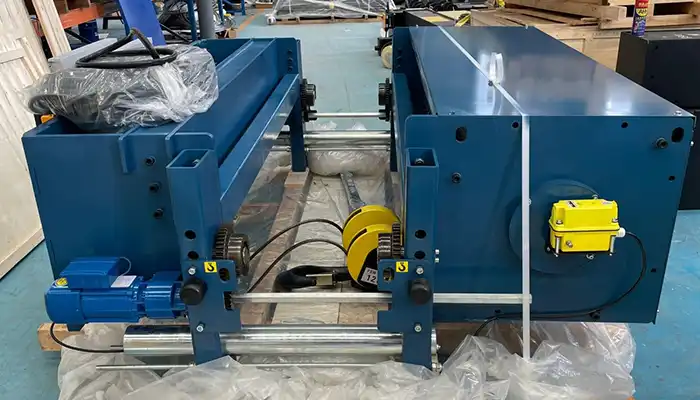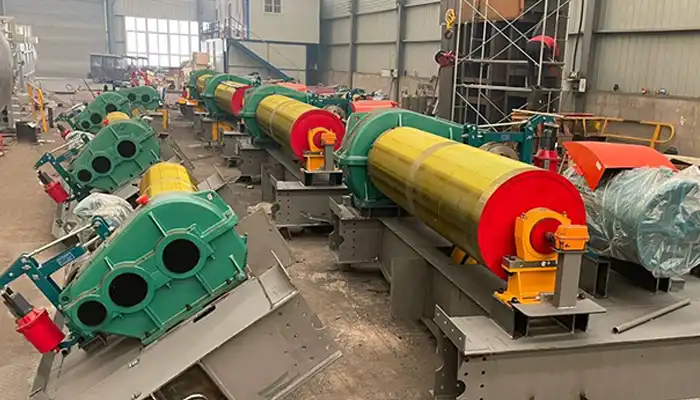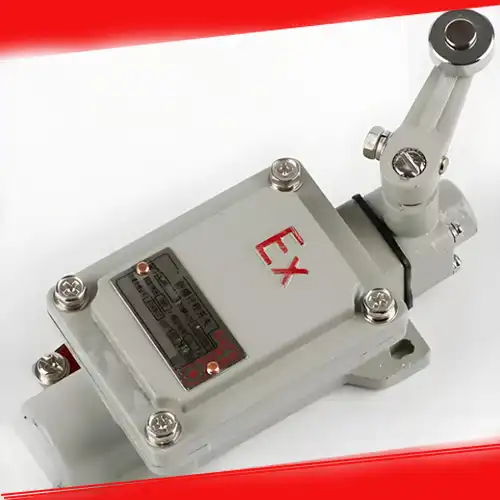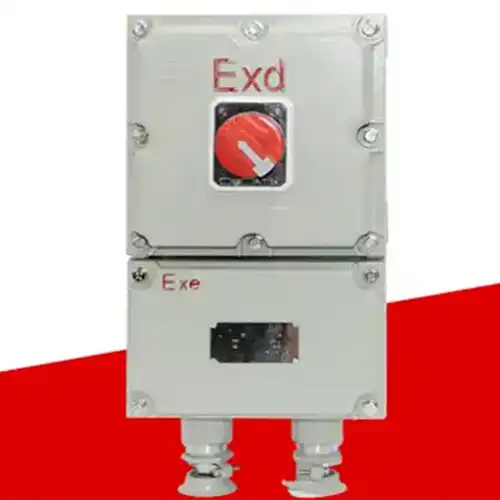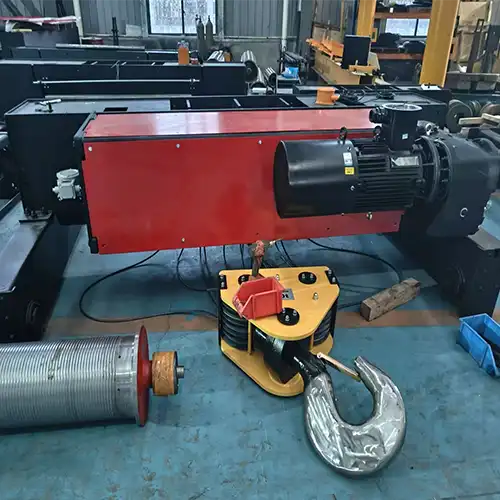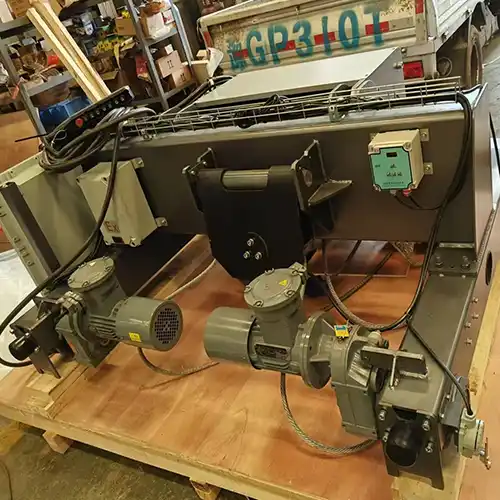Explosion-Proof Hook, Explosion Proof Crane Kit, Crane Hook
Explosion proof hook kit in hazardous environments, preventing sparks with non-sparking materials &certified explosion-proof standards for reliability.
Category: Crane Kit Parts
Your Trusted Explosion Proof Overhead Crane Kit Manufacturer & Supplier
Explosion-Proof Hook for Electric Hoist and Cranes in Explosive Environments
Safe Explosion Poof Hook Kit for Your Explosion Proof Crane Kit in
Introduction: What is Explosion-Proof Lifting Equipment?
In industries where flammable gas, vapor, dust, or fibers are present, every piece of equipment must be made safe—including lifting tools like electric hoists and cranes. That's where explosion-proof equipment comes in.
Explosion-proof lifting equipment is specially designed to avoid creating sparks, heat, or friction that could trigger a fire or explosion. It includes not only motors and controls, but also smaller parts like the hook. Yes—the hook matters a lot more than people often realize.

Why the Hook Needs to Be Explosion-Proof
The hook is the part of the hoist or crane that directly holds the load. During lifting operations, it's under constant movement, contact, and pressure. If the hook isn't explosion-proof and it strikes another object or surface, it can cause a spark.
Now, imagine that happening in a chemical plant or grain mill where fine particles or gas fill the air. One spark could lead to a serious accident.
So, an explosion-proof hook is not just a "nice to have." It's a must for safety.
Key reasons why explosion-proof hooks are important:
- Prevent sparks during lifting and contact
- Comply with safety regulations in hazardous areas
- Protect both workers and expensive machinery
- Reduce fire and explosion risks at the source
Industries That Rely on Explosion-Proof Hooks
Explosion-proof hooks are widely used in places where fire hazards are part of daily operations. These are usually environments with flammable gases, dust, or materials.
Here are some common examples:
- Petrochemical plants – oil, gas, and fuel transfer areas
- Mining sites – especially underground where gas pockets may form
- Paint and coating shops – where solvent fumes are everywhere
- Pharmaceutical plants & Chemical Plants – with fine powders and reactive substances
- Grab Crane for Grain storage and feed mills – where grain dust can explode if ignited
- Battery manufacturing – because of explosive vapors and chemical dust
- Waste treatment plants – especially those handling hazardous materials
Explosion-proof lifting gear, including hooks, is part of everyday life in these industries. It protects lives, prevents property damage, and helps companies stay compliant with international safety standards.
What Is an Explosion-Proof Hook?
The Role of a Hook in Electric Hoists and Cranes
The hook is the part of the hoist or crane that physically lifts the load.
It connects to the lifting medium—usually a sling, chain, or wire rope.
In daily lifting operations, the hook takes all the force. It must handle the load weight, shock, swinging motion, and sudden stops.
Without a reliable hook, no lifting can happen safely.
But in hazardous environments, it's not just about strength. It's also about safety under explosive conditions.
That's where explosion-proof hooks come in.
What Does "Explosion-Proof" Really Mean?
In industrial terms, explosion-proof doesn't mean the hook can survive an explosion.
It means the hook will not create a source of ignition—like a spark or high surface temperature—that could set off an explosion.
This is extremely important in environments with:
- Flammable gases (e.g., hydrogen, propane, acetylene)
- Combustible dusts (e.g., grain, sugar, metal powder)
- Chemical vapors or fibers (e.g., in coating or pharmaceutical plants)
In these places, even a tiny spark caused by metal contact could lead to fire or explosion. An explosion-proof hook is specially designed to prevent that spark from ever happening.

5 ton explosion proof hook - single girder overhead crane kit

80 ton explosion proof hook
What Makes an Explosion-Proof Hook Different?
Material Composition – Non-Sparking Alloys
Standard crane hooks are usually made of high-strength carbon steel or alloy steel.
These materials are durable but can produce sparks if they strike other hard surfaces.
Explosion-proof hooks are made from non-sparking materials, such as:
- Copper-Aluminum Alloy (Cu-Al) – soft, non-magnetic, and safe for use in Zone 1 & 2 explosive gas areas.
- Beryllium Copper (Cu-Be) – excellent mechanical strength and spark resistance.
- Nickel-Aluminum Bronze – good corrosion resistance and strength for marine or chemical industries.
These metals are softer than steel, but much safer when flammable materials are present. They are selected based on the explosive gas or dust classification at the site.
Surface Treatment – Anti-Corrosion & Anti-Static
Explosion-proof hooks are often treated with special coatings to make them even safer and more durable.
Typical treatments include:
- Anti-static coating – reduces the chance of static electricity building up on the surface.
- Electroplating or powder coating – prevents corrosion in chemical-rich environments.
- Smooth surface finishing – reduces friction and surface heat.
These treatments help the hook last longer and lower the risk of unexpected sparks or wear failures.
Safety-Focused Design Enhancements
Explosion-proof hooks are designed to avoid impact points and ensure safe load handling.
Key design upgrades may include:
- Rounded and polished contact surfaces to reduce metal impact risks.
- Latch locking systems that prevent accidental disengagement.
- Load indicators or test markings to show capacity and inspection records.
- No sharp edges or burrs, which could spark or cut into slings.
Some hooks also come with built-in swivel mechanisms to avoid load twisting, which can cause heat and friction.
If you're working in a hazardous area, every small safety upgrade makes a big difference.
Explosion-proof hooks may seem like a small detail, but they're a critical component in reducing fire and explosion risks.
Using the right hook can:
- Protect your workers and property
- Keep your facility compliant with safety codes like ATEX or IECEx
- Reduce downtime and long-term maintenance issues
In short, they're built to handle the job—safely, securely, and without any sparks.
Key Standards and Certifications
Why Explosion-Proof Certification Matters
Not every hook that claims to be "explosion-proof" is truly safe for hazardous areas.
That's why we rely on official standards. These standards define what explosion-proof really means, and how products are tested and certified.
For explosion-proof hooks, certification isn't just a label—it's proof the product is safe to use in explosive environments.
Main Explosion-Proof Standards
Here are some of the most widely recognized explosion-proof standards:
ATEX (EU Directive 2014/34/EU)
This is required in the European Union for equipment used in explosive atmospheres.
ATEX separates explosive zones based on how often gases or dusts are present.
IECEx (International Electrotechnical Commission System)
This is a global standard for explosion-proof equipment.
It provides a consistent system across many countries, even outside the EU.
GB3836 (China National Standard)
This is China's explosion-proof standard.
It applies to both electrical and mechanical equipment, including lifting hooks used in hazardous areas.
Each of these systems has testing rules, documentation requirements, and labeling instructions to ensure that equipment is safe for real use.
Understanding Certification Zones
Hazardous environments are divided into different zones depending on the type of risk—gas or dust—and how often that risk is present.
For explosive gases:
- Zone 0: Gas is present all the time or for long periods
- Zone 1: Gas may appear during normal operation
- Zone 2: Gas appears only occasionally and for a short time
For combustible dusts:
- Zone 20: Dust is always or almost always present
- Zone 21: Dust appears regularly in normal operation
- Zone 22: Dust appears sometimes, usually briefly
Explosion-proof hooks are typically certified for Zone 1 and Zone 2 (for gas) and Zone 21 and Zone 22 (for dust), depending on their materials and intended use.
How to Verify a Hook Is Certified
There are a few important things to check when confirming if a hook is explosion-proof:
Certification markings
A certified hook should have visible labels or engravings that include the relevant standard codes.
For example, you might see something like "Ex d IIB T6 Gb" or "Ex h IIC T4 Gb." These codes give details about the protection type, temperature class, and gas group.
Compliance certificate or test report
Ask the supplier for an official certificate or report from a third-party inspection company. This shows the hook passed required tests.
Declaration of conformity
This is a written statement from the manufacturer. It confirms that the product was made according to ATEX, IECEx, or GB3836 standards.
Traceable product information
Certified hooks should have a batch number or serial number. This helps you trace it back to the factory inspection records if needed.
If a hook doesn't have any of these, it might not be certified—and should not be used in explosive environments.
Explosion-proof certification isn't just paperwork. It's your assurance that the hook has been tested and approved to work safely in dangerous areas.
Always make sure the hook you buy meets the right standards for your site.
Technical Specifications and Parameters
Explosion-proof hooks are not all the same. Depending on the working conditions, capacity needs, and environmental hazards, the technical specifications can vary quite a bit.
Here's a breakdown of the most important technical factors to consider when choosing an explosion-proof hook for your electric hoist or crane.
Load Capacities
Explosion-proof hooks are available in a wide range of lifting capacities, just like standard crane hooks.
Common options include:
- 2 ton
- 3 ton
- 5 ton
- 10 ton
- 16 ton
- 20 ton or more
Larger capacities are usually custom-designed based on project requirements.
The load capacity must match the hoist or crane's rated lifting power. Never oversize or undersize the hook—both can be dangerous.
Operating Temperatures and Environment Suitability
Explosion-proof hooks are designed to work in extreme or unstable environments. That includes high-heat, dusty, humid, or gas-filled spaces.
Most certified hooks can safely operate in:
- Temperatures from -20°C to +60°C (standard)
- Some heavy-duty models can handle -40°C or up to +80°C with proper materials
Also, consider the surrounding atmosphere. Explosion-proof hooks are suitable for:
- Flammable gas zones (like petrochemical or gas plants)
- Combustible dust zones (like grain storage or paint shops)
- Wet, humid, or corrosive environments (like coastal or offshore applications)
Material Options and Coatings
The hook material plays a key role in preventing sparks and corrosion. Most explosion-proof hooks are made from non-sparking alloys, which are safe in explosive zones.
Typical material choices include:
- Copper-aluminum alloy (Cu-Al): A common choice for non-sparking performance
- Bronze or beryllium copper: For more demanding anti-spark applications
- Stainless steel (304 or 316): For corrosion resistance in marine or chemical areas
Surface coatings may include:
- Anti-static coatings to reduce charge buildup
- Anti-corrosion paint or galvanizing for longer outdoor use
- Powder coatings for additional wear protection
The exact choice depends on where and how the hook will be used.
Safety Factor Ratings
The safety factor tells you how much stronger the hook is than the rated load. This is important, especially in hazardous areas where failure is not an option.
Most explosion-proof hooks are built with:
- Safety factor of 4:1 or 5:1 for general industrial lifting
- Some heavy-duty or mission-critical hooks may go up to 6:1
For example, a 5-ton explosion-proof hook with a 5:1 safety factor can actually withstand 25 tons before failure.
But remember—it should never be loaded beyond its rated capacity during use.
Explosion-proof hooks aren't just about being spark-free. They're engineered to handle extreme environments, meet high safety expectations, and operate reliably under stress.
Knowing the technical specs helps you choose the right hook for the job—and avoid costly or dangerous mistakes.
Types of Explosion-Proof Hooks
Explosion-proof hooks are not one-size-fits-all.
Different types are made to suit different applications, lifting needs, and safety levels.
Below are the main types of explosion-proof hooks you'll come across, and how each one fits into specific industrial lifting setups.
Forged Alloy Hooks with Anti-Spark Coating
This is the most common type used in hazardous environments.
- These hooks are forged from high-strength non-sparking alloys, such as copper-aluminum or bronze-based metals.
- A special anti-spark coating is often added to the surface, further reducing the risk of ignition from friction or impact.
They are strong, durable, and widely used in gas plants, refineries, and chemical warehouses.
These hooks are typically paired with explosion-proof hoists and can handle standard lifting capacities from 1 ton to 20 tons or more.
Laminated Hooks for Added Safety
Laminated hooks are built from multiple layers (or laminates) of high-toughness materials stacked and bonded together.
- This design reduces internal stress and allows the hook to absorb impact energy more evenly.
- If the hook gets overloaded or cracked, only one layer may be damaged, so the hook still holds temporarily—giving time for safe shutdown.
Laminated hooks are less common but are often used in high-risk zones where any failure could be catastrophic.
They're ideal for mining sites, ammunition factories, or environments with frequent load shifts.
Swivel vs. Fixed Explosion-Proof Hooks
Hooks also come in two movement types: swivel and fixed.
Each has its purpose depending on how the load needs to be handled.
Swivel Hooks
- Can rotate freely or in a controlled way, allowing the load to turn without twisting the rope or chain
- Helpful when aligning heavy loads in tight spaces
- Usually come with a locking bearing to prevent unintentional spin during lifting
- Great for maintenance workshops, confined zones, or uneven terrain
Fixed Hooks
- No rotation; solidly connected to the hoist block
- Stronger in terms of direct lifting force and less complex mechanically
- Used in simpler vertical lifts where rotation isn't needed
- Common in warehouses and overhead crane systems with a straight-lift setup
Single Hook vs. Double Hook Configurations
The hook configuration also changes depending on how much weight you need to lift and how the load is distributed.
Single Hook
- One central lifting point
- Simple, lightweight, and ideal for light to medium-duty lifting
- Easy to maintain and install
- Common in low-height workshops and light hazard areas
Double Hook
- Two hooks work together on the same hoist trolley
- Designed for balanced lifting of long or large loads
- Helps reduce bending or tipping risks
- Often found in heavy-duty lifting operations like tank manufacturing or long steel beam handling
Choosing the right type of explosion-proof hook isn't just about load size.
It's also about the working environment, lifting behavior, and the safety level your operation demands.

Integration with Electric Hoists and Cranes
Explosion-proof hooks are often part of a larger system, including hoists and cranes, specifically designed for use in hazardous environments.
Understanding how these hooks integrate with hoists and crane systems ensures you're getting the safest, most efficient lifting solution for your operations.
Compatibility with Explosion-Proof Hoists and Crane Kits
Explosion-proof hooks must be compatible with the hoists and crane kits they are being used with. This ensures smooth operation, safety, and compliance with industry standards.
Key things to consider:
- Hoist type: Electric hoists are commonly used with explosion-proof hooks. Ensure the hoist is also explosion-proof and rated for the same zones (like Zone 1 or Zone 2 for gases, or Zone 21 or Zone 22 for dusts).
- Hook attachment: Make sure the hook design fits the hoist. Some hoists may require special adapters for explosion-proof hooks, depending on the lifting system's configuration.
- Load capacity matching: The hoist's load capacity must match the rated load capacity of the hook to avoid overloading.
Explosion-proof cranes, like overhead cranes, jib cranes, and gantry cranes, all need hooks that can handle the stresses and unique demands of explosive environments. Compatibility checks are essential to ensure all components work together without safety concerns.
Typical Applications in Overhead Cranes, Jib Cranes, and Gantry Cranes
Explosion-proof hooks are commonly used with several types of explosion proof cranes in industrial settings. These cranes are often found in hazardous zones, where sparks or mechanical failures can lead to dangerous explosions.
Explosion Proof Overhead Cranes
- These are the most common cranes for heavy-duty lifting in hazardous environments.
- Explosion-proof hooks are installed on the hoist trolley and used for lifting and moving large loads across production areas.
- Common in petrochemical plants, chemical processing, or pharmaceutical manufacturing.
Explosion Proof Jib Cranes
- Used in smaller, localized lifting tasks.
- They often require explosion-proof hooks when lifting smaller loads in hazardous areas.
- Jib cranes are especially useful in maintenance workshops or packaging lines where precision lifting is needed.
Explosion Proof Gantry Cranes
- Ideal for lifting large equipment, materials, or containers.
- Explosion-proof hooks on gantry cranes are used in shipyards, rail yards, or storage facilities where explosive gases or dust may be present.
- These cranes can be stationary or mobile, providing flexibility for different types of industrial settings.
Installation Considerations in Hazardous Areas
Installing explosion-proof hooks and their associated crane systems requires careful planning to maintain safety and ensure compliance with standards.
Some key installation considerations include:
- Proper grounding and bonding: Make sure the crane system is grounded to prevent static buildup, which could lead to sparks.
- Explosion-proof junction boxes: All electrical connections should use explosion-proof junction boxes to prevent sparking.
- Location of the crane: Install cranes in areas where they won't interfere with the hazardous materials or processes. For instance, place cranes in well-ventilated spaces to minimize the accumulation of flammable gases or dust.
- Explosion-proof wiring and connectors: Ensure that all wiring and connectors used in the crane system are rated for hazardous zones, keeping in line with relevant standards like ATEX or IECEx.
- Inspection and maintenance access: Design crane systems with easy access for regular inspections and maintenance, especially in high-risk areas.
Proper integration of explosion-proof hooks with hoists and cranes is vital for safe operation in hazardous environments.
Make sure to follow installation guidelines carefully and consult experts to ensure the equipment meets safety regulations.
Common Applications and Use Cases
Explosion-proof hooks are designed to handle the demands of hazardous environments where even a small spark or static charge can cause catastrophic incidents. These hooks are typically used in various lifting operations, including those in flammable gas or dust zones.
Lifting Operations in Flammable Gas or Dust Zones
Flammable Gas Zones
- Explosion-proof hooks are critical in areas where flammable gases are present, such as oil refineries, natural gas plants, and chemical processing plants.
- These gases can ignite easily, so using non-sparking hooks reduces the risk of accidental ignition when lifting heavy loads or moving materials.
Combustible Dust Zones
- Similarly, in dusty environments (e.g., grain storage, flour mills, and woodworking shops), the presence of fine dust particles creates an explosive atmosphere when combined with oxygen.
- Explosion-proof hooks help avoid sparking during lifting operations, ensuring safety in environments where dust accumulation can lead to deadly explosions.
Case Examples: Oil Refineries, Chemical Storage, Flour Mills, Etc.
- Oil Refineries: These are prime examples of places where explosion-proof hooks are used. These facilities handle volatile chemicals and fuels, and any spark can be disastrous. Lifting operations in such places require hooks designed to minimize the risk of ignition.
- Chemical Storage Facilities: In warehouses that store chemicals, particularly flammable ones like solvents or acids, explosion-proof hooks help ensure that the risk of sparks or electrical interference is eliminated.
- Flour Mills and Grain Storage: These industries produce a lot of fine particulate dust, which can create explosive atmospheres if exposed to sparks. Explosion-proof hooks are essential in these environments, where safety is a high priority.
Importance of Pairing with Other Explosion-Proof Components
Explosion-proof hooks don't work in isolation.
They must be paired with other explosion-proof components to ensure overall safety and functionality. Key components include:
- Explosion-Proof Motors: Motors that power the hoist or crane should also be rated for explosive environments to prevent sparks or overheating from causing an incident.
- Explosion-Proof Control Panels: The control system for the crane should be housed in explosion-proof enclosures to prevent any electrical faults from causing sparks in hazardous areas.
- Explosion-Proof Limit Switches: Limit switches help control the movement of the crane and hoist. If these are not explosion-proof, they can pose a risk in volatile atmospheres.
These components should be compatible and installed according to the standards, ensuring all safety measures are in place.

Explosion-Proof Motors

Explosion-Proof Control Panels

Explosion-Proof Limit Switches
Safety and Maintenance Guidelines
Maintaining explosion-proof hooks is essential for their continued safe operation. Regular inspections, proper maintenance, and knowing when to replace worn-out parts are critical to reducing risks and ensuring compliance with safety standards.
Regular Inspection Protocols
To keep your explosion-proof hook in top working condition, follow a regular inspection schedule. Inspections should include:
- Visual checks: Look for cracks, deformation, or signs of wear that might weaken the hook.
- Functional checks: Test the hook's movement and operation. Ensure it moves smoothly without binding or excessive friction.
- Corrosion checks: Look for signs of rust or corrosion, especially in areas where the hook may be exposed to harsh chemicals or weather.
Remember, inspecting your hooks should be done regularly—at least once a month—and more frequently if the environment is particularly harsh.
Preventive Maintenance to Avoid Corrosion or Spark Risk
Explosion-proof hooks are exposed to harsh environments, so preventive maintenance is key to extending their life. Here's what to focus on:
- Cleaning: Regularly clean the hook to remove dirt, dust, or chemicals that could cause damage or increase the risk of corrosion. Use a non-corrosive cleaning solution to avoid further damage.
- Lubrication: Apply lubricant to moving parts as required to prevent friction and wear. Be careful to use non-flammable lubricants that won't add risk in explosive environments.
- Anti-corrosion treatments: If the hook is exposed to extreme environmental conditions, reapply anti-corrosion coatings periodically to protect against rust and degradation.
Replacement Guidelines for Worn or Damaged Explosion-Proof Hooks
No matter how well-maintained, hooks can wear out or become damaged over time. Here's how to determine when a replacement is necessary:
- Check the Load Capacity: If the hook has experienced excessive load or stress beyond its rated capacity, it should be replaced.
- Inspect for Cracks or Deformation: Any cracks, significant wear, or bent parts compromise the strength and safety of the hook. If this happens, replace the hook immediately.
- Surface Damage: If the anti-spark coating is worn or damaged, it could lead to dangerous sparks. Replace the hook if the coating is compromised.
By following these safety and maintenance guidelines, you'll ensure that your explosion-proof hooks continue to perform safely and effectively in hazardous environments. Proper care extends the life of your equipment, reduces downtime, and most importantly, keeps your team safe.
Choosing the Right Explosion-Proof Hook
When selecting an explosion-proof hook, buyers must consider various factors to ensure they're choosing the best fit for their operations. The right hook will depend on factors such as load rating, environmental conditions, and compatibility with other equipment. Let's break down the key factors to consider and the questions you should ask your suppliers.
Factors Buyers Should Consider
Load Rating
The load rating of the hook is one of the most critical aspects. You need to choose a hook that is rated for the maximum load your operation will lift.
- Match the load capacity: If you're lifting heavier loads than the hook is rated for, you risk equipment failure, which could cause accidents. Make sure the hook's load rating is appropriate for the lifting tasks.
- Safety margin: It's a good idea to select a hook with a safety factor higher than the actual load. This provides extra assurance that the hook will hold up under stress.
Certification Requirements
Ensure that the explosion-proof hook meets the necessary certification standards. These certifications guarantee the hook has been tested and approved for use in hazardous environments.
- Look for ATEX or IECEx certifications. These standards show that the hook is designed to work safely in explosive gas or dust atmospheres.
- Ask for zone-specific certifications (e.g., Zone 1 for explosive gas environments or Zone 21 for dust).
- Make sure the hook's certification matches the zone of your facility.
Environmental Conditions
Consider the environmental conditions where the hook will be used. Different hazardous environments require different types of explosion-proof hooks.
- Temperature: Will the hook be used in high or low temperatures? Choose hooks with the right material and coatings to withstand temperature extremes.
- Corrosive environments: If the hook will be exposed to chemicals, moisture, or other corrosive elements, ensure it has an anti-corrosion treatment like zinc plating or ceramic coating.
- Dust: If your environment has a high dust concentration (e.g., in grain storage or flour mills), you'll need a hook designed to handle dust explosions.
Hook Type and Compatibility
Explosion-proof hooks come in different designs, such as swivel, fixed, single, or double hooks. Ensure the hook you choose matches your lifting operation's needs.
- Swivel hooks: Ideal for maneuvering loads in tight spaces or for multi-directional lifting.
- Fixed hooks: Suitable for straightforward, vertical lifting.
- Single vs. double hooks: Depending on the load size and balance required, you'll need to choose between single or double hook configurations.
Also, ensure that the hook is compatible with the hoist or crane system you plan to use. It should fit seamlessly into your lifting setup without requiring extensive modifications.
Questions Buyers Should Ask Suppliers
When talking to suppliers, it's important to ask the right questions to ensure the hook meets your needs. Here are a few key questions to ask:
Before making a purchase, it's important to gather as much information as possible. Here are the key questions you should ask:
- What certifications does the hook have?
Ensure the hook complies with international safety standards such as ATEX or IECEx to guarantee it's suitable for explosive environments. - What is the load rating?
Ask about the hook's maximum load capacity and confirm that it meets your lifting requirements. It's essential that the hook can handle your specific operational needs. - What material is the hook made of?
Inquire whether the hook is forged from non-sparking alloys or has an anti-spark coating, which is critical to preventing sparks in hazardous areas. - What environmental conditions can the hook handle?
Ensure the hook is designed to withstand the specific conditions of your environment, such as extreme temperatures, corrosive chemicals, or dusty surroundings. - Can the hook be customized?
Check if the hook can be tailored to meet your specific requirements, such as adjustments to size, coating, or compatibility with your existing crane or hoist systems. - What kind of warranty and support do you offer?
Understand the supplier's warranty, after-sales support, and maintenance services in case the hook needs repairs or replacement. - How do you test the hooks for explosion-proof standards?
Confirm that the supplier follows strict testing protocols to ensure the hook meets the required explosion-proof standards and performs safely in hazardous conditions.
Choosing the right explosion-proof hook is crucial to ensuring safety, efficiency, and compliance in hazardous environments. By carefully considering the factors listed above and asking the right questions, you can make a well-informed decision that suits your lifting needs.
Conclusion
Explosion-proof hooks play a critical role in ensuring safety and reliability in environments where the risk of fire or explosion is high. Whether it's in oil refineries, chemical plants, or grain storage, these hooks help prevent sparks and minimize hazards during lifting operations. Their specialized materials, certifications, and design enhancements make them essential for protecting workers and equipment in volatile atmospheres.
If you're considering explosion-proof hooks for your operation, don't hesitate to reach out for quotes or technical consultations. Our team is ready to help you select the best equipment for your needs and ensure compliance with safety standards.
Main Projects
Related Products
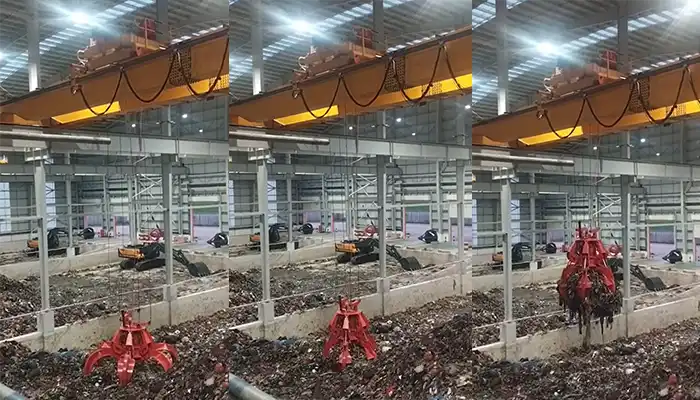
Supplied three grab bucket crane kits to Indonesia, enhancing garbage handling efficiency with high load capacity and reliable performance.
Free consultation to Confirm Parameters & Specifications and Get
Latest Crane Price & Crane Rate.
- Types of overhead cranes : _______?
- Optional: Overhead travelling crane, goliath gantry crane,Slewing jib crane, Single girder or double girder crane,small portable crane or kbk crane, etc.
- Capacity of overhead crane: _______?
- Optional: 0.25ton, 0.5 ton, 1 ton, 2 ton, 3ton, 5 ton, 10 ton,15ton, 20ton, 25 ton, 30ton,35ton, up to 550ton, etc.
- Crane span & lifting height : _______?
- Crane travelling length : _____?
- Control of overhead crane:_______?
- Optional: pendant/ remote/cabin control
- Voltage supply of overhead crane:_____?
- Eg,: 380V50/60HZ,3Phase or others,etc.
- Application/usage of crane:_______?
- Eg,: Steel mill, ,injection mold, cement,stone, concrete,granite, general manufacturing, etc.
Just leave a message via the contact form and our hoist and crane engineer will contact you with in 24working hours.
Get In Touch
